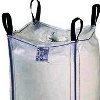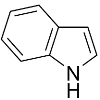| Anmol Chemicals is the pioneer manufacturers of Skatole & Indole, Pharmaceutical Excipients Fragrance Food & Flavor chemicals in India. We offer Halal and Kosher Skatole & Indole made in an ISO9001, ISO22000 (FSSC22000) cGMP and GLP certified facility. Our group has several manufacturing facilities spread across the world, supported by toll manufacturers and representatives in UAE, Europe, Africa, USA, China and has several associated manufacturing facilities spread across India. All the Information on Physics, Chemistry, Applications, Uses and Technology on Manufacture of Skatole & Indole is in these pages. |
| The units in the group have one or more of the certifications like FDA GMP, ISO 9001, ISO 22000, HACCP, REACH, Kosher & Halal and DMF support is available. |






Skatole GHS SDS, Safety Data Sheet
Skatole Manufacturer's Specifications
Indole Manufacturer's Specifications
YOU ARE HERE Skatole GHS SDS
SKATOLE SDS GHS, MSDS SHEET, MATERIAL SAFETY DATA SHEET
Section 1: Chemical Product and Identification
Product Name: 3-Methylindole, Skatole
CAS#: 83-34-1
EC Number: 201-471-7
Chemical Name: 3-Methylindole
Chemical Formula: C9-H9-N
Molecular Weight: 131.17
IUPAC Name: 3-methyl-1H-indole
Synonyms: Skatole, Scatole, Skatol, 3-METHYLINDOLE, 3-Methyl-1H-indole, beta-Methylindole, Indole, 3-methyl-, 1H-Indole, 3-methyl-, 3 Methylindole, 3-methylindoline, methyl-3-indole, .beta.-Methylindole, 3-Methyl-4,5-benzopyrrole, 3-MI, FEMA No. 3019, Skatole
Section 2: Hazards Identification
GHS, Globally Harmonized System Classification in accordance with 29 CFR 1910
Classification according to Regulation (EC) No 1272/2008
Skin corrosion/irritation Category 3
Serious eye damage/eye irritation Category 2A
Specific target organ toxicity, single exposure; Respiratory tract irritation Category 3
Hazardous to the aquatic environment, long-term hazard Category 2
Labeling according Regulation (EC) No 1272/2008
GHS Label Elements Aquatic Toxicity |
|
Signal Words: Warning
Hazard Statements:
H315: Causes skin irritation.
H319: Causes serious eye irritation.
H335: May cause respiratory irritation.
H411: Toxic to aquatic life with long lasting effects.
Precautionary Statements:
P264: Wash … thoroughly after handling.
P273: Avoid release to the environment.
P280: Wear protective gloves/protective clothing/eye protection/face protection.
P302+352: IF ON SKIN: Wash with soap and water.
P332+313: If skin irritation occurs: Get medical advice/attention.
P305+351+338: IF IN EYES: Rinse cautiously with water for several minutes. Remove contact lenses if present and easy to do – continue rinsing.
P337+313: If eye irritation persists get medical advice/attention.
P362: Take off contaminated clothing and wash before reuse.
P391: Collect spillage.
P501: Dispose of contents/container in accordance with local/national regulation.
Classification according to EU Directives 67/548/EEC or 1999/45/EC:
Xi, N Irritant, Dangerous for the environment
R36/37/38, R51/53
For the full text of the H-statements & R-phrases mentioned in this Section, see Section 16.
Section 3: Composition and Information on Ingredients
Composition: {3-}Methylindole, Skatole
CAS Number: 83-34-1
EINECS EC Number: 201-471-7
% by Weight: 100
Section 4: First Aid Measures
Eye Contact: Check for and remove any contact lenses. Immediately flush eyes with running water for at least 15 minutes, keeping eyelids open. Cold water may be used. Do not use an eye ointment. Seek medical attention.
Skin Contact: After contact with skin, wash immediately with plenty of water. Gently and thoroughly wash the contaminated skin with running water and non-abrasive soap. Be particularly careful to clean folds, crevices, creases and groin. Cover the irritated skin with an emollient. If irritation persists, seek medical attention. Wash contaminated clothing before reusing.
Serious Skin Contact: Wash with a disinfectant soap and cover the contaminated skin with an anti-bacterial cream. Seek medical attention.
Inhalation: Allow the victim to rest in a well ventilated area. Seek immediate medical attention.
Serious Inhalation: Not available.
Ingestion: Do not induce vomiting. Loosen tight clothing such as a collar, tie, belt or waistband. If the victim is not breathing, perform mouth-to-mouth resuscitation. Seek immediate medical attention.
Section 5: Fire and Explosion Data
Flammability of the Product: Skatole may be combustible at high temperature.
Auto-Ignition Temperature: Not available.
Flash Point: Not available.
Flammable Limits: Not available.
Products of Combustion: These products are carbon oxides (CO, CO2), along with some NOx.
Fire Hazards in Presence of Various Substances: Not available.
Fire Fighting Media and Instructions:
SMALL FIRE: Use DRY chemical powder.
LARGE FIRE: Use water spray, fog or foam. Avoid water jet.
Section 6: Accidental Release Measures
Small Spill: Use appropriate tools to put the spilled solid in a convenient waste disposal container. Finish cleaning by spreading water on the contaminated surface and dispose of according to local and regional authority requirements.
Large Spill: Use a shovel to put the material into a convenient waste disposal container. Finish cleaning by spreading water on the contaminated surface and allow to evacuate through the sanitary system.
Section 7: Handling and Storage
Contains no substances with occupational exposure limit values.
Precautions: Keep away from heat. Keep away from sources of ignition. Empty containers pose a fire risk; evaporate the residue under a fume hood. Ground all equipment containing material. Do not ingest. Do not breathe dust. Wear suitable protective clothing.
Storage: Keep Skatole container dry. Keep in a cool place. Ground all equipment containing material. Keep container tightly closed. Keep in a cool, well-ventilated place. Combustible materials should be stored away from extreme heat and away from strong oxidizing agents.
Section 8: Exposure Controls/Personal Protection
Engineering Controls: Use process enclosures, local exhaust ventilation, or other engineering controls to keep airborne levels below recommended exposure limits. If user operations generate dust, fume or mist, use ventilation to keep exposure to airborne contaminants below the exposure limit.
Personal Protection: Splash goggles. Lab coat. Dust respirator. Be sure to use an approved/certified respirator or equivalent. Gloves.
Personal Protection in Case of a Large Spill: Splash goggles. Full suit. Dust respirator. Boots. Gloves. A self contained breathing apparatus should be used to avoid inhalation of the product. Suggested protective clothing might not be sufficient; consult a specialist for handling this product.
Section 9: Physical and Chemical Properties
Physical state and appearance: Solid. (Crystalline solid, flakes or powder).
Odor: Unpleasant.
Taste: Not available.
Molecular Weight: 131.18 g/mole
Color: Whit to Off White.
pH (1% solution/water): Not available.
Boiling Point: 265.5C (509.9F)
Melting Point: 95.5C (203.9F)
Dispersion Properties: Partially dispersed in hot water, n-octanol. Very slightly dispersed in cold water, methanol, and diethyl ether. See solubility in methanol, diethyl ether, n-octanol, and acetone.
Solubility: Partially soluble in hot water, methanol, diethyl ether, n-octanol, acetone. Very slightly soluble in cold water.
Section 10: Stability and Reactivity Data
Stability: Skatole is stable.
Incompatibility with various substances: Reactive with oxidizing agents, acids.
Corrosivity: Not available.
Polymerization: No.
Section 11: Toxicological Information
Toxicity to Animals: Acute oral toxicity (LD50): 3450 mg/kg [Rat].
Carcinogenic Effects: Classified None. by NTP, None. by OSHA, None. by NIOSH.
Mutagenic Effects: Not available.
Teratogenic Effects: Not available.
Developmental Toxicity: Not available.
Section 12: Ecological Information
Toxicity to fish: LC50 - Pimephales promelas (fathead minnow) - 8,84 mg/l - 96 h
BOD5 and COD: Not available.
Products of Biodegradation: Possibly hazardous short term degradation products are not likely. However, long term degradation products may arise.
Toxicity of the Products of Biodegradation: The product itself and its products of degradation are not toxic.
Section 13: Disposal Considerations
Waste Disposal: To be done as per local laws.
Section 14: Transport Information
DOT (US)
UN number: 3335 Class: 9
Proper shipping name: Aviation regulated solid, n.o.s. (3-Methylindole)
Marine pollutant: No
Poison Inhalation Hazard: No
IMDG
UN number: 3335 Class: 9 Packing group: III
Proper shipping name: ENVIRONMENTALLY HAZARDOUS SUBSTANCE, SOLID, N.O.S. (3-Methylindole)
IATA
UN number: 3335 Class: 9 Packing group: III
Proper shipping name: Aviation regulated solid, n.o.s. (3-Methylindole)
ADR/RID
UN number: 3335 Class: 9 Packing group: III
Proper shipping name: ENVIRONMENTALLY HAZARDOUS SUBSTANCE, SOLID, N.O.S. (3-Methylindole)
Section 15: Other Regulatory Information
US Federal and State Regulations:
TSCA 12(b): Not applicable
SARA 302: No chemicals in this material are subject to the reporting requirements of SARA Title III, Section 302.
SARA 313: Not applicable
SARA 311/312:
Acute Health Hazard
Clean Water Act: Not applicable
Clean Air Act: Not applicable
OSHA Hazards:
Irritant
CERCLA:
Not applicable
California Proposition 65: This product does not contain any Proposition 65 chemicals.
Massachusetts Right To Know Components: No components are subject to the Massachusetts Right to Know Act.
Pennsylvania Right To Know Components:
3-Methylindole, CAS-No. 83-34-1
New Jersey Right To Know Components:
3-Methylindole CAS-No. 83-34-1
EINECS: This product is on the European Inventory of Existing Commercial Chemical Substances.
WHMIS (Canada): CLASS D-2A: Material causing other toxic effects (VERY TOXIC).
DSCL (EEC):
R36/37/38- Irritating to eyes, respiratory system and skin.
HMIS (Perceived):
Health Hazard: 2
Fire Hazard: 1
Reactivity: 0
Personal Protection: E
NFPA (Perceived):
Health: 2
Flammability: 1
Reactivity: 0
Specific hazard:
Protective Equipment:
Gloves. Lab coat. Dust respirator. Be sure to use an approved/certified respirator or equivalent. Wear appropriate respirator when ventilation is inadequate. Splash goggles.
16. Other Information
H315: Causes skin irritation.
H319: Causes serious eye irritation.
H335: May cause respiratory irritation.
H411: Toxic to aquatic life with long lasting effects.
N = Dangerous for the environment
Xi = Irritant
R36/37/38 = Irritating to eyes, respiratory system and skin.
R51/53 = Toxic to aquatic organisms, may cause long-term adverse effects in the aquatic
environment.
S-phrase(s): S26 - In case of contact with eyes, rinse immediately with plenty of water and seek medical advice. S36 - Wear suitable protective clothing.
Disclaimer:
******************************
Our company provides this Skatole MSDS sheet in good faith but makes no representation as to its comprehensiveness or accuracy. This SDS sheet is intended only as a guide to the appropriate precautionary handling of the material by a properly trained person using this product. The above information has been compiled from various sources and has the possibility of discrepancy and being out-dated information. Individuals receiving the information must exercise their independent judgment and do further search in determining its appropriateness for a particular purpose. In no case shall our company be liable to loss or damages by the product user.
******************************
Skatole & Indole Manufacturers
Anmol Chemicals
S-8, SARIFA MANSION, 2ND FLANK ROAD, CHINCHBUNDER, MUMBAI 400009, INDIA
TEL: (OFFICE) 91-22-23770100, 23726950, 23774610, 23723564. FAX: 91-22-23728264
e-mail: anmolc@mtnl.net.in

Exports to USA, Canada, UAE, Dubai, South Africa, Tanzania, Kenya, Nigeria, Egypt, Uganda, Turkey, Mexico, Brazil, Chile, Argentina, Europe Netherlands, Italy, Spain, Germany, Portugal, France, Malaysia, Indonesia, Thailand, Vietnam, Korea, Japan, etc.
Copyright and Usual Disclaimer is Applicable
